Birthday Party
Prev
Next
|
Day 3: March 26, 2006 Birthday Party |
Prev Next |
|
|
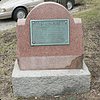
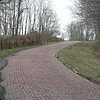 During the First World War, some 75 miles of National Road in eastern Ohio
were paved with brick to make it suitable for transporting military
supplies. Several sections survive including this one leading into the
town of Norwich. Norwich is also where Christopher Baldin died when the
stagecoach in which he was riding left the road and overturned. That was
in 1835 and the monument identifies Baldwin as
Ohio's first traffic fatality. The identification includes the qualifier
"on record" leaving open the possibility that one or more unknowns had
previously been done in by a loose Conestoga or runaway ox cart without
notifying the authorities. Maybe the absence of authorities had something
to do with that.
During the First World War, some 75 miles of National Road in eastern Ohio
were paved with brick to make it suitable for transporting military
supplies. Several sections survive including this one leading into the
town of Norwich. Norwich is also where Christopher Baldin died when the
stagecoach in which he was riding left the road and overturned. That was
in 1835 and the monument identifies Baldwin as
Ohio's first traffic fatality. The identification includes the qualifier
"on record" leaving open the possibility that one or more unknowns had
previously been done in by a loose Conestoga or runaway ox cart without
notifying the authorities. Maybe the absence of authorities had something
to do with that.
|
|
|
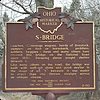
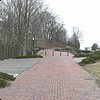
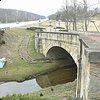
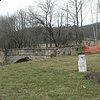
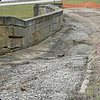 S-bridges were a fairly common feature of the National Road and several
survive between Zanesville and Bridgeport. One of the best examples is the
Fox Run Bridge near New Concord. A small parking area is reached via a
section of brick road that also leads to the well preserved bridge. The
last two pictures show a bridge in very different condition. One end of
the Peters Creek Bridge has started to collapse and the arch is filled
with metal supports that prevent it caving in completely. Even in this
deteriorated state, it is better off than those S-bridges that have
completely disappeared.
S-bridges were a fairly common feature of the National Road and several
survive between Zanesville and Bridgeport. One of the best examples is the
Fox Run Bridge near New Concord. A small parking area is reached via a
section of brick road that also leads to the well preserved bridge. The
last two pictures show a bridge in very different condition. One end of
the Peters Creek Bridge has started to collapse and the arch is filled
with metal supports that prevent it caving in completely. Even in this
deteriorated state, it is better off than those S-bridges that have
completely disappeared.
|
|
|
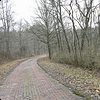
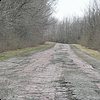 This brick section of the National Road now bears the name Peacock Road.
At some point in its life, it was covered with asphalt. Now, the asphalt
is mostly worn away to expose the nearly 90 year old brick surface.
This brick section of the National Road now bears the name Peacock Road.
At some point in its life, it was covered with asphalt. Now, the asphalt
is mostly worn away to expose the nearly 90 year old brick surface.
|
|
|
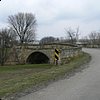
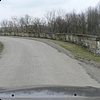 This bridge over Salt Fork near Melbourne is one of the few place where
you can satisfy a desire to drive across an S-bridge. It's off of the main
route now but has certainly seen a huge amount and an incredible variety
of traffic in the approximately 180 years that it has stood here.
This bridge over Salt Fork near Melbourne is one of the few place where
you can satisfy a desire to drive across an S-bridge. It's off of the main
route now but has certainly seen a huge amount and an incredible variety
of traffic in the approximately 180 years that it has stood here.
|
|
|
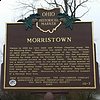
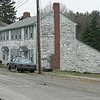
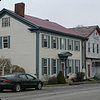
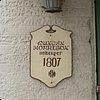
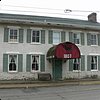 This is Morristown and the first picture is of the Black Horse Inn. As it
approaches 200 years of age, it is for sale and appears in decent
condition. Many buildings display wooden plaques, like this one at the
Black Horse, to identify and date them. In general, I thought Morristown a
fairly sad place; filled with some of the good and a lot of the bad that
comes from being bypassed. The town dates from 1802 and was on Zane's
Trace long before the National Road came through. (My failure to get a
picture of Church Street/Zane's Trace is a real embarrassment.) Main
Street seems to be reverting to its original state with long stretches of
gravel on the former National Road section. There are some signs of a care
population. Across the street from the Black Horse is a well maintained
house and a nice car complete with vanity plate. But the adjoining I.O.O.F
hall could do with a lot of work and, back on the Black Horse side of the
street, a neglected double wide I-house is fronted by a jacked up car with
no license plate at all.
This is Morristown and the first picture is of the Black Horse Inn. As it
approaches 200 years of age, it is for sale and appears in decent
condition. Many buildings display wooden plaques, like this one at the
Black Horse, to identify and date them. In general, I thought Morristown a
fairly sad place; filled with some of the good and a lot of the bad that
comes from being bypassed. The town dates from 1802 and was on Zane's
Trace long before the National Road came through. (My failure to get a
picture of Church Street/Zane's Trace is a real embarrassment.) Main
Street seems to be reverting to its original state with long stretches of
gravel on the former National Road section. There are some signs of a care
population. Across the street from the Black Horse is a well maintained
house and a nice car complete with vanity plate. But the adjoining I.O.O.F
hall could do with a lot of work and, back on the Black Horse side of the
street, a neglected double wide I-house is fronted by a jacked up car with
no license plate at all.
|
|
|
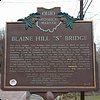
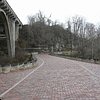
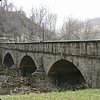 Built in 1828, the Blaine Hill Bridge is
believed to be the oldest standing bridge in Ohio. Next to it, the 1933
viaduct carries US-40 traffic. Even higher, sits I-70 and, although the
road itself cannot be seen from the old bridge, semi-trucks are quite
visible as they pass by on the interstate.
Built in 1828, the Blaine Hill Bridge is
believed to be the oldest standing bridge in Ohio. Next to it, the 1933
viaduct carries US-40 traffic. Even higher, sits I-70 and, although the
road itself cannot be seen from the old bridge, semi-trucks are quite
visible as they pass by on the interstate.
|
|
|
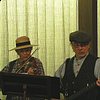
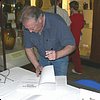
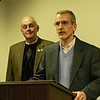
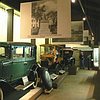
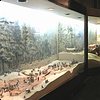
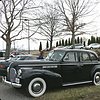 I entered West Virginia just so I could drive over that wonderful old
suspension bridge then jumped on I-70 to get back for the open house at
the National Road Museum. The online information gave a start time of 2:00
but the actual time was something much earlier. When I arrived around
1:30, the parking lot was overflowing and the museum was definitely
crowded. Refreshments were served and the entire museum was available for
viewing. The Ohio Historical
Society has published an excellent traveler's guide and its authors,
Doug Smith & Glenn Harper, were in attendance; Signing copies and
giving short presentations. Russell Poole was also there signing copies of
his new photo book, America's Road, and several road related
organizations had representatives manning tables. There was even
background music from this talented trio.
I entered West Virginia just so I could drive over that wonderful old
suspension bridge then jumped on I-70 to get back for the open house at
the National Road Museum. The online information gave a start time of 2:00
but the actual time was something much earlier. When I arrived around
1:30, the parking lot was overflowing and the museum was definitely
crowded. Refreshments were served and the entire museum was available for
viewing. The Ohio Historical
Society has published an excellent traveler's guide and its authors,
Doug Smith & Glenn Harper, were in attendance; Signing copies and
giving short presentations. Russell Poole was also there signing copies of
his new photo book, America's Road, and several road related
organizations had representatives manning tables. There was even
background music from this talented trio.
The open house was the trip's finale and I left it to follow expressways home. After days of skies that were usually grey when they weren't producing some form of wetness, the sun was out when I headed home; Just in time to be in my eyes. |
| [Prev] [Site Home] [Home] [Contact] [Next] |